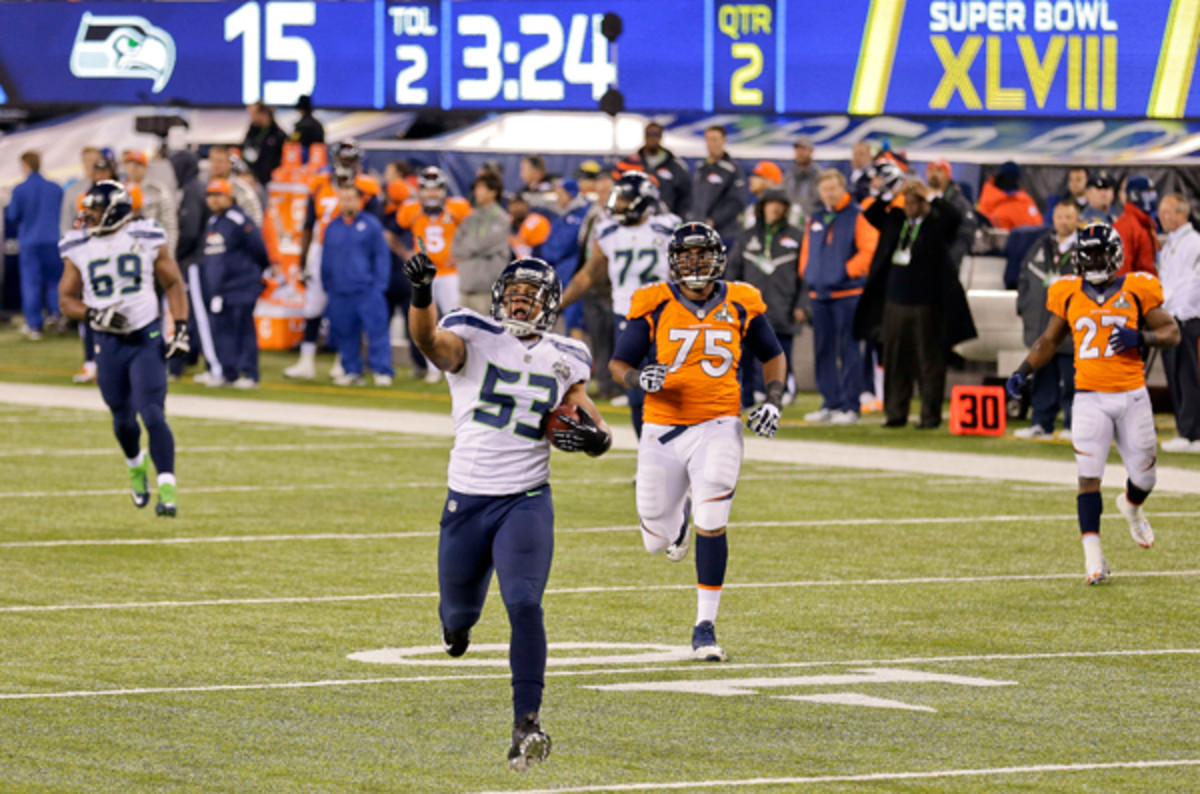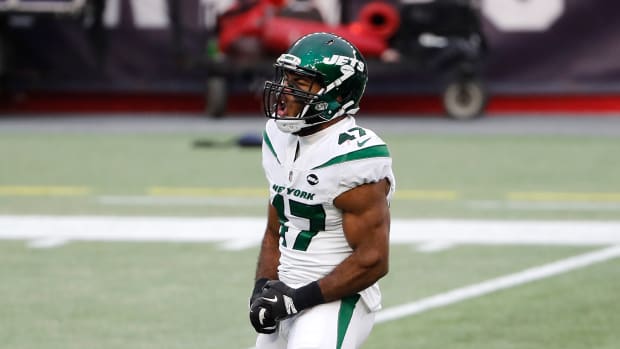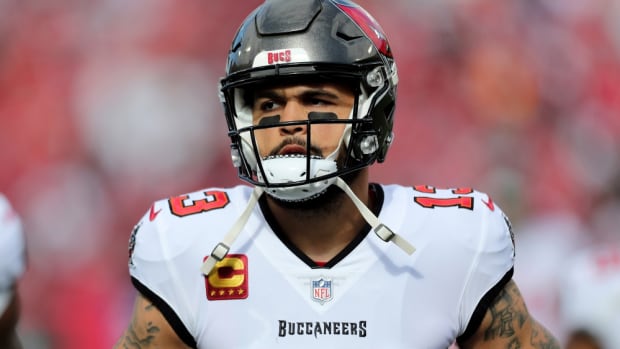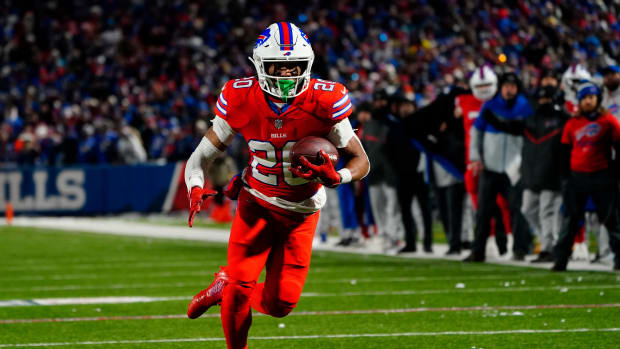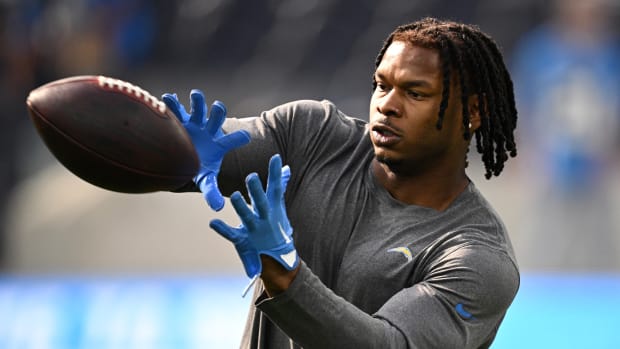Seattle's defensive blueprint is a myth, but it remains a topic of discussion
Seattle's defense led the way in Super Bowl XLVIII. Will the rest of the NFL look to follow? (Gregory Bull/AP)
INDIANAPOLIS -- It could be argued, given the offense they were facing, and the ways in which things have been made easier for offenses in general in the NFL through the last decade or so, that the Seattle Seahawks' 43-8 thrashing of the Denver Broncos in Super Bowl XLVIII was the most impressive performance by a defense in the history of America's biggest game. Seattle shut down Peyton Manning and his cadre of impressive receivers, scoring as many points on the defensive side of the ball as Denver did overall.
Of course, the NFL is a copycat league, so some would have you believe that there is a blueprint to what the Seahawks have done in the last four years under general manager John Schneider and head coach Pete Carroll. And there are undeniably unique elements to what they do -- the Seahawks eschew ultra-complex zone defenses (for the most part) in favor of tight, aggressive coverage at all levels of the field. Their linemen have to be versatile enough to play in multiple fronts, and their linebackers must be rangy enough to play in a 360-degree space.
Easy to say, hard to do. And during the scouting combine, several coaches and executives were eager to talk about that blueprint -- Seattle's intruiging mix of new-school schemes and old-school toughness and aggression. Whether they would cop to actually perusing the recipe was another matter.
"Yes and no," Arizona Cardinals general manager Steve Keim told me on Thursday. "In one aspect ... I mean, John Schneider's done a great job. And when you look at Seattle's defense, it's a pretty common denominator. There's a lot of big, fast, productive players. And that's always our goal -- universally -- is to find guys like that. They have great perimeter pass-rushers, guys who can go inside and out. And that's what you're looking for. Guys who have interchangeable value and can play in multiple fronts. Earl Thomas and Richard Sherman are elite cover guys -- they're aggressive and physical, so they all fit that scheme. Defensively, I think we're close, but there are a few more pieces of the puzzle we need to add. But the way we played defensively last year, I'm extremely proud."
MORE: 2014 NFL Mock Draft | 2014 NFL Draft Big Board | Burning questions for combine
As he should be. The Cardinals finished second to Seattle in Football Outsiders' opponent-adjusted defensive rankings, and they're as close as any team to meeting or exceeding what the Seahawks have accomplished, with first-year defensive coordinator Todd Bowles leading the way in 2013.
"Any time you have a new staff, you've got to have some time with your players to understand their limitations, and Todd did a great job of putting those players in a position to succeed," Keim said. "He catered to their strengths and tried to hide some of their weaknesses. Todd's a great young coach. I think everybody understands what his value within the league is, obviously [he] garnered a lot of attention after the season as a head coach candidate. He has a great understanding of our personnel and how things fit."
John Schneider (left) and Pete Carroll spent four years building the NFL's best defense. (Elaine Thompson/AP)
And that's a huge part of the key -- mix your coaches and players in a perfect storm. As he told me on Friday (and has said many times through his time in Seattle), Carroll knows that it starts with an overall gameplan. Then you build over time. And if you're lucky, you get the youngest team to ever win a Super Bowl, and a defense that had just one starter (defensive tackle Brandon Mebane) and one other primary player (defensive lineman Red Bryant) come with you from beginning to end.
“It really starts with an overall philosophy," Carroll said of the alleged blueprint. "How the game works, which is eliminating big plays and playing big up front. That’s kind of the basics of it, and you have to kind of build from that. You have to start somewhere. We have a really sound mentality and we build from that -- we’ve been doing that for years. This is not just a one-year or a two-year deal. That guides the standards that we set, so we’re so good up top. If you look at our defense and how well we play down the middle, for years, it’s been that way. That’s one of the building blocks of it -- that you’re really good up top.
“We don’t let people score fast. Scoring fast with the running game is really important. As you move forward, you want to be more and more aggressive, and always with speed. That’s kind of the general way of saying it. But if you don’t have a really clear vision of what you’re creating, then one year it’ll be this, one year, it’ll be that. I think we have a really solid mentality with what we’re trying to do on defense.”
Broncos head coach John Fox, whose history is on the defensive side of the ball, saw Seattle's defense more as a problem his team was not able to solve than an object lesson from a future planning standpoint.
“I played in the Super Bowl in 2000 [as the New York Giants' defensive coordinator], against the Baltimore Ravens, which was probably record-wise the best defense ever in the league. That game kind of went similar. They’re very talented, good length, good speed, and you don’t trot through the regular season being the best defense in the league for nothing. They’re very good."
Most teams looking for a Seattle-type score seem to look at the cornerbacks Carroll and Schneider have developed -- longer, more rangy guys who can play press and trail receivers down the field. But that was never really cornerback Brandon Browner's specialty, and cornerback Richard Sherman -- a former receiver at Stanford - had a specific athleticism and competitive drive when the Seahawks took him in the fifth round of the 2011 draft. The rarity of those specific height/speed players, as Carroll said, is clear.
"Everybody would like to longer, taller guys that run 4.4. But there just aren’t many humans like that in the world. It’s rare when you find them. Then you have to develop them. The perfect guys aren’t there. There’s no really tall, exceedingly fast guys other than a handful, like Calvin [Johnson] and a few others. You have to make those guys come to life through your coaching and how you adapt their style and ability to fit it. We've been doing it for a long time and always been looking for longer guys because we have such a commitment to bump-and-run press corners. This goes back 20 years. It’s not new for us.
"It's rare that you can find them. When we had Brandon [Browner] and Richard [Sherman] playing [together] ... you can’t get any longer than that. That’s the two tallest corners that played together, arguably in the history of the league. OK, let’s go do that. There are no players like that. Look at this draft -- here are only a couple guys who are over 6-foot-1 at corner. That’s just how it goes.
"So, I love people trying to copy that. Get a bunch of tall guys out there. That's awesome."
In other words, none of this is simple. As much as the Seahawks have similarities to certain modern defenses, there's a definite element of the great defenses of the 1970s and early '80s in what they do. It's something Carroll has committed to for a long time.
And Steelers general manager Kevin Colbert's response to the blueprint question made it clear that although everyone in the league admires what's been built in the Emerald City, not everyone is going to scrap what they're doing -- especially teams like Colbert's, with a long and rich history of doing defense the right way -- their own way.
"My hat is off to John Schneider and Pete Carroll," Colbert said Thursday. "They put together a great program. That’s a program that is unique to them. We have 32 teams. We are all different. We are made up differently. We all have different philosophies. Their philosophy was the one that won the Super Bowl this year. Again, congratulations to them. Their makeup is different than our makeup. It’s different than New England’s. It’s different than everybody’s. You have to be individual to your own organization and try to do what you can do within your constraints. So, to try to copy any offense, defense and an organization, I think you’d be wasting your time. You have to be unique to yourself."
That's what the Seahawks have been saying all along, though you can expect certain elements of their modus operandi to trickle through the league in certain places. And that's the real story -- Seattle doesn't have a repeatable blueprint, and that's true of any great organization. It's organically created over time, and with vision.
“I think it’s just about trying to improve every single day in every aspect of acquisition," Schneider told me. "I think our staff is open-minded so they’re able to adjust on the fly. We moved Red Bryant [from defensive tackle to defensive end] when we got here. We knew he was a big powerful man, so they wanted to put him in a specific position to accentuate his strengths. I think coach Carroll and his staff are very good at listening and being open-minded about players, whether it’s a conversion player.
"Blueprint-wise? I’d love to say this is exactly how you do it, but really it’s about getting up every day and trying to improve in every aspect that you can.”
































